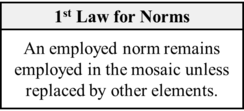Difference between revisions of "Mechanism of Scientific Inertia for Methods"
(Created page with "{{Topic |Subject=Method |Topic Type=Descriptive |Subfield=Dynamics |Inherited From=Mechanism of Scientific Inertia for Epistemic Elements |Heritable=No |Question Text Formula=...") |
|||
| Line 5: | Line 5: | ||
|Inherited From=Mechanism of Scientific Inertia for Epistemic Elements | |Inherited From=Mechanism of Scientific Inertia for Epistemic Elements | ||
|Heritable=No | |Heritable=No | ||
| − | |Question Text Formula= | + | |Question Text Formula=What makes the <subjects> of an agent's mosaic continue to remain in the mosaic? |
|Question Title Formula=Mechanism of Scientific Inertia for <Subjects> | |Question Title Formula=Mechanism of Scientific Inertia for <Subjects> | ||
| − | |Question= | + | |Question= |
| − | |Question Title= | + | |Question Title= |
|Predicate=mechanism of inertia | |Predicate=mechanism of inertia | ||
|Object Type=Text | |Object Type=Text | ||
Latest revision as of 12:17, 20 June 2024
What makes the methods of an agent's mosaic continue to remain in the mosaic?
It is important to specify the conditions under which an employed method stays employed.
In the scientonomic context, this question was first formulated by Hakob Barseghyan in 2015. The question is currently accepted as a legitimate topic for discussion by Scientonomy community.
In Scientonomy, the accepted answer to the question is:
- An employed norm remains employed in the mosaic unless replaced by other elements.
Contents
Scientonomic History
Acceptance Record of the Question
| Community | Accepted From | Acceptance Indicators | Still Accepted | Accepted Until | Rejection Indicators |
|---|---|---|---|---|---|
| Scientonomy | 1 January 2016 | This is when the community accepted its first answer to the question, The First Law for Methods (Barseghyan-2015), which indicates that the questions is itself considered legitimate. | Yes |
All Direct Answers
| Theory | Formulation | Formulated In |
|---|---|---|
| The First Law for Methods (Barseghyan-2015) | An employed method remains employed unless replaced by other methods. | 2015 |
If a direct answer to this question is missing, please click here to add it.
Accepted Direct Answers
| Community | Theory | Formulation | Accepted From | Accepted Until |
|---|---|---|---|---|
| Scientonomy | The First Law for Methods (Barseghyan-2015) | An employed method remains employed unless replaced by other methods. | 1 January 2016 | 22 February 2024 |
Suggested Modifications
Current View
In Scientonomy, the accepted answer to the question is The First Law for Norms (Barseghyan-Pandey-2023).
Mechanism of Scientific Inertia for Normative Theories
The First Law for Norms (Barseghyan-Pandey-2023) states: "An employed norm remains employed in the mosaic unless replaced by other elements."
Unlike Barseghyan's initial formulation of the first law for methods, Pandey's formulation accomplishes two things. First, it applies to norms of all types rather than merely to methods. Second, it allows for norms to be replaced by elements of any type, not merely by other norms.1pp. 28-29
Related Topics
This question is a subquestion of Mechanism of Scientific Inertia for Normative Theories.
References
- ^ Pandey, Aayu. (2023) Dilemma of the First Law. Scientonomy 5, 25-46. Retrieved from https://scientojournal.com/index.php/scientonomy/article/view/42258.
